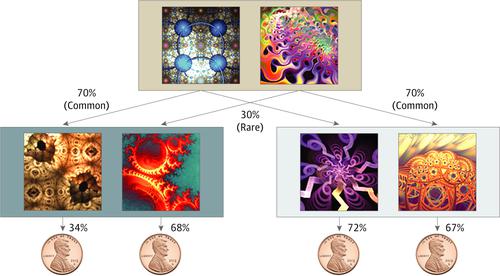当前位置:
X-MOL 学术
›
JAMA Psychiatry
›
论文详情
Our official English website, www.x-mol.net, welcomes your
feedback! (Note: you will need to create a separate account there.)
Comparison of the Association Between Goal-Directed Planning and Self-reported Compulsivity vs Obsessive-Compulsive Disorder Diagnosis.
JAMA Psychiatry ( IF 22.5 ) Pub Date : 2019-10-09 , DOI: 10.1001/jamapsychiatry.2019.2998 Claire M Gillan 1 , Eyal Kalanthroff 2 , Michael Evans 3 , Hilary M Weingarden 4, 5 , Ryan J Jacoby 4, 5 , Marina Gershkovich 6, 7 , Ivar Snorrason 5, 8 , Raphael Campeas 6, 7 , Cynthia Cervoni 9 , Nicholas Charles Crimarco 6 , Yosef Sokol 10, 11, 12 , Sarah L Garnaat 13, 14 , Nicole C R McLaughlin 13, 14 , Elizabeth A Phelps 15 , Anthony Pinto 16 , Christina L Boisseau 17 , Sabine Wilhelm 4, 5 , Nathaniel D Daw 18 , H B Simpson 6, 7
JAMA Psychiatry ( IF 22.5 ) Pub Date : 2019-10-09 , DOI: 10.1001/jamapsychiatry.2019.2998 Claire M Gillan 1 , Eyal Kalanthroff 2 , Michael Evans 3 , Hilary M Weingarden 4, 5 , Ryan J Jacoby 4, 5 , Marina Gershkovich 6, 7 , Ivar Snorrason 5, 8 , Raphael Campeas 6, 7 , Cynthia Cervoni 9 , Nicholas Charles Crimarco 6 , Yosef Sokol 10, 11, 12 , Sarah L Garnaat 13, 14 , Nicole C R McLaughlin 13, 14 , Elizabeth A Phelps 15 , Anthony Pinto 16 , Christina L Boisseau 17 , Sabine Wilhelm 4, 5 , Nathaniel D Daw 18 , H B Simpson 6, 7
Affiliation

|
Importance
Dimensional definitions of transdiagnostic mental health problems have been suggested as an alternative to categorical diagnoses, having the advantage of capturing heterogeneity within diagnostic categories and similarity across them and bridging more naturally psychological and neural substrates.
Objective
To examine whether a self-reported compulsivity dimension has a stronger association with goal-directed and related higher-order cognitive deficits compared with a diagnosis of obsessive-compulsive disorder (OCD).
Design, Setting, and Participants
In this cross-sectional study, patients with OCD and/or generalized anxiety disorder (GAD) from across the United States completed a telephone-based diagnostic interview by a trained rater, internet-based cognitive testing, and self-reported clinical assessments from October 8, 2015, to October 1, 2017. Follow-up data were collected to test for replicability.
Main Outcomes and Measures
Performance was measured on a test of goal-directed planning and cognitive flexibility (Wisconsin Card Sorting Test [WCST]) and a test of abstract reasoning. Clinical variables included DSM-5 diagnosis of OCD and GAD and 3 psychiatric symptom dimensions (general distress, compulsivity, and obsessionality) derived from a factor analysis.
Results
Of 285 individuals in the analysis (mean [SD] age, 32 [12] years; age range, 18-77 years; 219 [76.8%] female), 111 had OCD; 82, GAD; and 92, OCD and GAD. A diagnosis of OCD was not associated with goal-directed performance compared with GAD at baseline (β [SE], -0.02 [0.02]; P = .18). In contrast, a compulsivity dimension was negatively associated with goal-directed performance (β [SE], -0.05 [0.02]; P = .003). Results for abstract reasoning task and WCST mirrored this pattern; the compulsivity dimension was associated with abstract reasoning (β [SE], 2.99 [0.63]; P < .001) and several indicators of WCST performance (eg, categories completed: β [SE], -0.57 [0.09]; P < .001), whereas OCD diagnosis was not (abstract reasoning: β [SE], 0.39 [0.66]; P = .56; categories completed: β [SE], -0.09 [0.10]; P = .38). Other symptom dimensions relevant to OCD, obsessionality, and general distress had no reliable association with goal-directed performance, WCST, or abstract reasoning. Obsessionality had a positive association with requiring more trials to reach the first category on the WCST at baseline (β [SE], 2.92 [1.39]; P = .04), and general distress was associated with impaired goal-directed performance at baseline (β [SE],-0.04 [0.02]; P = .01). However, unlike the key results of this study, neither survived correction for multiple comparisons or was replicated at follow-up testing.
Conclusions and Relevance
Deficits in goal-directed planning in OCD may be more strongly associated with a compulsivity dimension than with OCD diagnosis. This result may have implications for research assessing the association between brain mechanisms and clinical manifestations and for understanding the structure of mental illness.
中文翻译:

目标导向的计划与自我报告的强迫性与强迫症诊断之间的关联性比较。
重要性已经提出了诊断性心理健康问题的维度定义,可以作为分类诊断的替代方法,其优点是可以捕获诊断类别中的异质性以及它们之间的相似性,并桥接更自然的心理和神经基础。目的探讨与强迫症(OCD)的诊断相比,自我报告的强迫性维度与目标导向及相关的更高阶认知缺陷之间是否具有更强的关联性。设计,环境和参与者在本横断面研究中,来自美国各地的患有强迫症和/或广泛性焦虑症(GAD)的患者完成了由受过培训的评估者进行的基于电话的诊断访谈,基于互联网的认知测试和自我评估。自2015年10月8日起报告的临床评估,至2017年10月1日。收集了后续数据以测试可复制性。主要结果和指标绩效是通过目标导向的计划和认知灵活性测试(威斯康星卡片分类测试[WCST])和抽象推理测试进行衡量的。临床变量包括通过因素分析得出的OCD和GAD的DSM-5诊断以及3种精神症状的维度(一般困扰,强迫和强迫症)。结果分析的285个人(平均[SD]年龄:32 [12]岁;年龄范围:18-77岁;女性219 [76.8%]),有强迫症(OCD)111;82,GAD;92,OCD和GAD。与基线时的GAD相比,OCD的诊断与目标导向的表现无关(β[SE],-0.02 [0.02]; P = .18)。相反,强制性维度与目标导向的绩效负相关(β[SE],-0.05 [0.02];P = 0.003)。抽象推理任务和WCST的结果反映了这种模式。强制性维度与抽象推理(β[SE],2.99 [0.63]; P <.001)和WCST性能的多个指标(例如,已完成的类别:β[SE],-0.57 [0.09]; P <。 001),而未进行OCD诊断(抽象推理:β[SE],0.39 [0.66]; P = .56;已完成类别:β[SE],-0.09 [0.10]; P = .38)。与强迫症,强迫症和一般困扰有关的其他症状维度与目标绩效,WCST或抽象推理之间没有可靠的关联。强迫症与需要更多的试验以达到基线的WCST第一类指标呈正相关(β[SE],2.92 [1.39]; P = .04),而一般困扰与基线时目标导向的表现受损有关( β[SE],-0.04 [0.02]; P =。01)。但是,与这项研究的关键结果不同,该方法在多次比较中都没有幸免于校正,也没有在后续测试中得到重复。结论和相关性强迫症方面,与强迫症相比,强迫症中目标导向计划的缺陷可能比强迫症更强烈。该结果可能对评估大脑机制与临床表现之间的关联以及对理解精神疾病的结构的研究具有启示意义。
更新日期:2020-01-02
中文翻译:

目标导向的计划与自我报告的强迫性与强迫症诊断之间的关联性比较。
重要性已经提出了诊断性心理健康问题的维度定义,可以作为分类诊断的替代方法,其优点是可以捕获诊断类别中的异质性以及它们之间的相似性,并桥接更自然的心理和神经基础。目的探讨与强迫症(OCD)的诊断相比,自我报告的强迫性维度与目标导向及相关的更高阶认知缺陷之间是否具有更强的关联性。设计,环境和参与者在本横断面研究中,来自美国各地的患有强迫症和/或广泛性焦虑症(GAD)的患者完成了由受过培训的评估者进行的基于电话的诊断访谈,基于互联网的认知测试和自我评估。自2015年10月8日起报告的临床评估,至2017年10月1日。收集了后续数据以测试可复制性。主要结果和指标绩效是通过目标导向的计划和认知灵活性测试(威斯康星卡片分类测试[WCST])和抽象推理测试进行衡量的。临床变量包括通过因素分析得出的OCD和GAD的DSM-5诊断以及3种精神症状的维度(一般困扰,强迫和强迫症)。结果分析的285个人(平均[SD]年龄:32 [12]岁;年龄范围:18-77岁;女性219 [76.8%]),有强迫症(OCD)111;82,GAD;92,OCD和GAD。与基线时的GAD相比,OCD的诊断与目标导向的表现无关(β[SE],-0.02 [0.02]; P = .18)。相反,强制性维度与目标导向的绩效负相关(β[SE],-0.05 [0.02];P = 0.003)。抽象推理任务和WCST的结果反映了这种模式。强制性维度与抽象推理(β[SE],2.99 [0.63]; P <.001)和WCST性能的多个指标(例如,已完成的类别:β[SE],-0.57 [0.09]; P <。 001),而未进行OCD诊断(抽象推理:β[SE],0.39 [0.66]; P = .56;已完成类别:β[SE],-0.09 [0.10]; P = .38)。与强迫症,强迫症和一般困扰有关的其他症状维度与目标绩效,WCST或抽象推理之间没有可靠的关联。强迫症与需要更多的试验以达到基线的WCST第一类指标呈正相关(β[SE],2.92 [1.39]; P = .04),而一般困扰与基线时目标导向的表现受损有关( β[SE],-0.04 [0.02]; P =。01)。但是,与这项研究的关键结果不同,该方法在多次比较中都没有幸免于校正,也没有在后续测试中得到重复。结论和相关性强迫症方面,与强迫症相比,强迫症中目标导向计划的缺陷可能比强迫症更强烈。该结果可能对评估大脑机制与临床表现之间的关联以及对理解精神疾病的结构的研究具有启示意义。











































 京公网安备 11010802027423号
京公网安备 11010802027423号